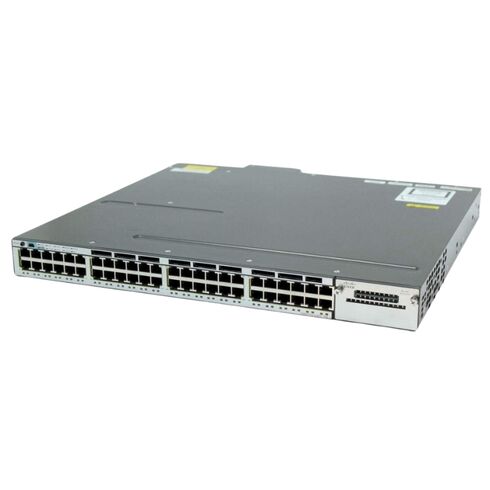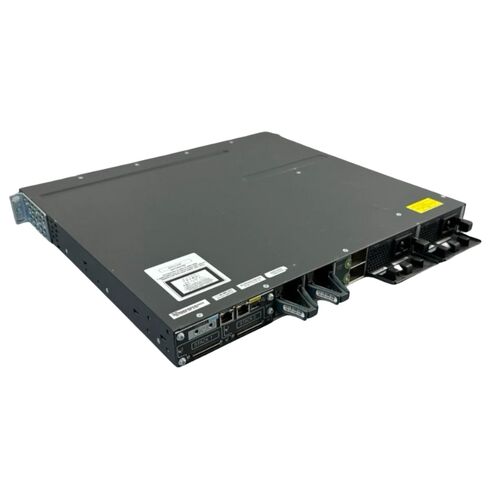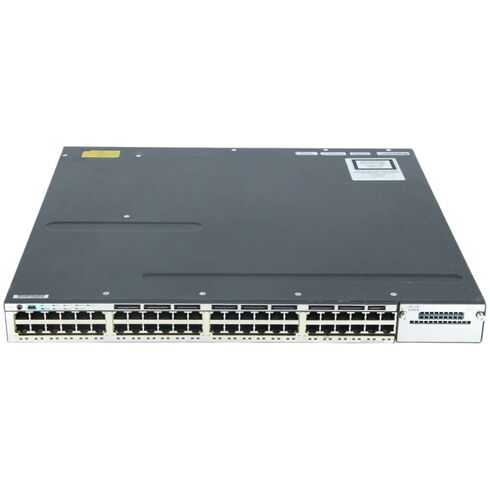WS-C3750X-48P-E Cisco Catalyst Switch Managed L3 Poe+ Ethernet (48 Port)
- — Free Ground Shipping
- — Min. 6-month Replacement Warranty
- — Genuine/Authentic Products
- — Easy Return and Exchange
- — Different Payment Methods
- — Best Price
- — We Guarantee Price Matching
- — Tax-Exempt Facilities
- — 24/7 Live Chat, Phone Support
- — Visa, MasterCard, Discover, and Amex
- — JCB, Diners Club, UnionPay
- — PayPal, ACH/Bank Transfer (11% Off)
- — Apple Pay, Amazon Pay, Google Pay
- — Buy Now, Pay Later - Affirm, Afterpay
- — GOV/EDU/Institutions PO's Accepted
- — Invoices
- — Deliver Anywhere
- — Express Delivery in the USA and Worldwide
- — Ship to -APO -FPO
- — For USA - Free Ground Shipping
- — Worldwide - from $30
Same product also available in:
| SKU/MPN | Warranty | Price | Condition | You save |
|---|---|---|---|---|
| WS-C3750X-48P-E | 1 Year Warranty | $209.00 | Excellent Refurbished | You save: $73.15 (26%) |
| WS-C3750X-48P-E | 1 Year Warranty | $8,990.00 | Factory-Sealed New Retail in Original Box (FSB) | You save: $3,146.50 (26%) |
Overview of the Cisco WS-C3750X-48P-E Switch
Product Specifications
- Manufacturer: Cisco
- Model Number: WS-C3750X-48P-E
- Product Type: Managed Switch
- Form Factor: Rack-mountable (1U)
Key Features
Port Configuration
- Device Type: Stackable Managed Switch
- Ethernet Interfaces: Gigabit Ethernet
- Ports: 48 x 10/100/1000 with PoE+
- Power over Ethernet (PoE): PoE+ with a budget of 435W
Performance Metrics
- Switching Fabric Bandwidth: 160 Gbps
- Forwarding Rate: 101.2 Mpps
Capacity Features
- VLAN Support: Up to 1005
- Switched Virtual Interfaces (SVIs): 1000
- Jumbo Frame Capability: 9216 bytes
Routing Capabilities
- Supported Protocols: RIP-1, RIP-2, HSRP, Static IP Routing, RIPng
Remote Management Options
- Management Protocols: SNMP (Versions 1, 2, 2c, 3), RMON (1, 2, 3, 9), Telnet, TFTP, SSH, CLI
Advanced Features
- Hot-swappable Module Replacement
- Layer 2 Switching Capabilities
- Dynamic IP Address Assignment with DHCP Support
- Auto-negotiation and ARP Support
- Trunking and VLAN Capabilities
- Auto-uplink (Auto MDI/MDI-X) Support
- IGMP Snooping for multicast traffic management
- Traffic Shaping and Broadcast Storm Control
- High Availability Features
- Rapid Spanning Tree Protocol (RSTP) Compliance
- Dynamic Trunking Protocol (DTP) Support
- Port Aggregation Protocol (PAGP) Capability
- Access Control List (ACL) Functionality
- Quality of Service (QoS) Support
- Dynamic ARP Inspection (DAI)
- Cisco StackWise Technology Integration
- Per-VLAN Spanning Tree Plus (PVST+)
- EIGRP Stub Routing Support
- Link Aggregation Control Protocol (LACP)
- Remote Switch Port Analyzer (RSPAN) Functionality
Compliance Standards
- IEEE 802.3, IEEE 802.3u, IEEE 802.3z, IEEE 802.1d
- IEEE 802.1q, IEEE 802.3ab, IEEE 802.1p, IEEE 802.3af
- IEEE 802.3x, IEEE 802.3ad (LACP), IEEE 802.1w
- IEEE 802.1x, IEEE 802.1s, IEEE 802.1ae, IEEE 802.3at
Power Specifications
- Input Voltage: AC 120/230 V (50/60 Hz)
- Power Redundancy: Optional
Managed: 1
The Cisco WS-C3750X-48P-E Catalyst Switch is a highly advanced and feature-rich network switch that offers comprehensive management capabilities. With its managed functionality, this switch provides users with complete control over their network infrastructure, allowing them to monitor, configure, and optimize network performance.
Benefits of Managed Switches
Managed switches like the Cisco WS-C3750X-48P-E Catalyst Switch offer several key benefits for users:
1. Enhanced Network Security
One of the primary advantages of a managed switch is the ability to implement robust network security measures. With advanced features such as access control lists (ACLs), VLANs, and port security, users can define and enforce security policies to protect their network from unauthorized access and potential threats.
By segmenting the network into separate virtual LANs (VLANs), administrators can isolate sensitive data and restrict access based on user roles or departments. This helps prevent unauthorized users from gaining access to critical resources or sensitive information.
2. Improved Network Performance
A managed switch allows for better control and optimization of network traffic, which ultimately leads to improved network performance. With features like Quality of Service (QoS) and traffic prioritization, administrators can prioritize critical applications or services, ensuring that they receive sufficient bandwidth and minimal latency.
Furthermore, the ability to monitor network traffic and analyze performance metrics enables proactive troubleshooting and capacity planning. Administrators can identify bottlenecks or congestion points in the network and take appropriate measures to optimize performance and ensure smooth operation.
3. Flexibility and Scalability
A managed switch offers greater flexibility and scalability compared to unmanaged switches. With the ability to configure advanced features and protocols, users can adapt the switch to meet their specific network requirements.
Managed switches also support features like Virtual Router Redundancy Protocol (VRRP) and Link Aggregation Control Protocol (LACP), allowing for high availability and increased bandwidth. These features enable the creation of redundant links or aggregated links between switches, ensuring network resilience and efficient utilization of network resources.
4. Centralized Management
With a managed switch, network administrators can centrally manage and configure multiple switches from a single interface. This centralized management simplifies network administration tasks, reduces complexity, and saves time and effort.
Administrators can deploy network-wide changes or configurations simultaneously, eliminating the need to manually configure each switch individually. This not only improves efficiency but also ensures consistency across the network.
Importance of Managed Switches
Managed switches are essential for organizations that require a high level of control, security, and performance in their network infrastructure. These switches provide the foundation for building a robust and reliable network that can support the evolving needs of modern businesses.
Whether it's a small office or a large enterprise, a managed switch offers the flexibility and scalability to accommodate growing networks and changing requirements. It empowers administrators to optimize network performance, secure sensitive data, and streamline network management processes.
Layer: 3
The Cisco WS-C3750X-48P-E Catalyst Switch is a Layer 3 switch, which means it operates at the network layer of the OSI model. This layer provides the capability to route traffic between different IP subnets or VLANs, making the switch an integral part of a complex network infrastructure.
Benefits of Layer 3 Switches
Layer 3 switches offer several key benefits for users:
1. Efficient Traffic Routing
As a Layer 3 switch, the Cisco WS-C3750X-48P-E Catalyst Switch can perform routing functions, allowing it to direct traffic efficiently between different subnets or VLANs. This eliminates the need for an external router in many cases, simplifying the network architecture and reducing costs.
By leveraging its routing capabilities, the Layer 3 switch can make intelligent forwarding decisions based on IP addresses, ensuring that traffic reaches its destination using the most optimal path. This helps improve network performance and reduces latency.
2. Enhanced Network Segmentation
Layer 3 switches enable network segmentation by creating separate IP subnets or VLANs. This provides several benefits, including improved security, simplified network management, and better resource allocation.
By dividing the network into smaller segments, administrators can control access and restrict communication between different segments. This helps mitigate the risk of unauthorized access or potential security breaches.
In addition, network segmentation facilitates easier management and troubleshooting. Administrators can apply different policies or configurations to each segment, making it easier to isolate and resolve issues without impacting the entire network.
3. Scalability and Flexibility
A Layer 3 switch offers greater scalability and flexibility compared to Layer 2 switches. With its routing capabilities, it can support a larger number of IP subnets or VLANs, accommodating the growth of the network.
Layer 3 switches also support advanced routing protocols such as OSPF (Open Shortest Path First) or EIGRP (Enhanced Interior Gateway Routing Protocol), enabling dynamic routing and automatic network discovery. This makes it easier to scale the network and adapt to changes without manual configuration.
4. Convergence of Voice and Data
Layer 3 switches play a crucial role in the convergence of voice and data networks. By supporting features like Quality of Service (QoS) and Voice VLANs, these switches can prioritize voice traffic and ensure optimal voice quality.
With the increasing adoption of Voice over IP (VoIP) systems, having a Layer 3 switch becomes essential for organizations that rely on seamless communication between different locations or departments.
Importance of Layer 3 Switches
Layer 3 switches are vital components of modern network infrastructures, especially in environments that require efficient routing, network segmentation, and support for advanced protocols.
Whether it's a large enterprise with multiple branches or a campus network with diverse requirements, a Layer 3 switch provides the necessary capabilities to build a scalable, secure, and high-performance network. It enables organizations to optimize traffic flow, enhance security, and streamline network operations.
PoE+: 1
The Cisco WS-C3750X-48P-E Catalyst Switch supports Power over Ethernet Plus (PoE+), a technology that enables the switch to provide both data connectivity and electrical power to connected devices through a single Ethernet cable.
Benefits of PoE+
PoE+ offers several key benefits for users:
1. Simplified Deployment
PoE+ eliminates the need for separate power adapters or electrical outlets for powered devices. This simplifies the deployment process and reduces the cost and complexity of installing power infrastructure.
With PoE+, devices such as IP phones, wireless access points, or security cameras can be easily connected to the switch using standard Ethernet cables. This flexibility allows for greater flexibility in device placement and reduces the dependency on power outlets.
2. Increased Flexibility and Mobility
PoE+ enables greater flexibility and mobility by providing power to devices that may not have easy access to electrical outlets. This is particularly beneficial in environments such as open office spaces, conference rooms, or outdoor areas.
Wireless access points can be strategically placed without the limitation of power source availability, ensuring optimal Wi-Fi coverage. Similarly, IP phones can be deployed at any location within the network, facilitating hot-desking or flexible work environments.
3. Cost Savings
PoE+ eliminates the need for additional power infrastructure, resulting in cost savings. The installation and maintenance of power outlets can be a significant expense, especially in large-scale deployments.
By leveraging PoE+, organizations can reduce both upfront and operational costs associated with powering devices. This makes it an attractive solution for businesses looking to optimize their budget without compromising functionality.
4. Centralized Power Management
PoE+ switches provide centralized power management capabilities, allowing administrators to monitor and control the power consumption of connected devices. This helps optimize power usage, identify potential issues, and ensure efficient utilization of resources.
Administrators can set power budgets or limits for individual ports or groups of ports, preventing devices from exceeding their allocated power budget. They can also remotely power cycle devices or prioritize critical devices during power outages or emergencies.
Importance of PoE+
PoE+ has become an essential feature for organizations that rely on a wide range of powered devices in their network infrastructure. It simplifies deployment, enhances flexibility, reduces costs, and provides centralized power management capabilities.
Whether it's a small office, a campus environment, or an industrial setting, PoE+ enables organizations to maximize the potential of their network infrastructure. It facilitates the deployment of various devices, ensures connectivity in challenging areas, and streamlines power management processes.
Ports: 48
The Cisco WS-C3750X-48P-E Catalyst Switch offers 48 Ethernet ports, providing ample connectivity options for a wide range of devices. These ports support both data and power transmission, making them versatile and suitable for various network environments.
Benefits of 48 Ports
The availability of 48 ports on the Cisco WS-C3750X-48P-E Catalyst Switch offers several key benefits for users:
1. Scalability and Expansion
With 48 ports, the switch provides ample room for network expansion and growth. Organizations can connect a large number of devices to the switch, ensuring that they have the necessary network connectivity to support their operations.
Whether it's connecting computers, servers, IP phones, wireless access points, or other network devices, the switch's 48 ports enable organizations to scale their networks without limitations.
2. Simplified Network Infrastructure
Having a sufficient number of ports helps simplify the network infrastructure by reducing the need for additional switches or complex cabling arrangements. With 48 ports, organizations can consolidate their network devices and create a more streamlined and efficient network architecture.
By minimizing the number of switches required, organizations can reduce complexity, enhance manageability, and lower operational costs. This makes it easier to monitor and troubleshoot the network, improving overall network performance.
3. Flexibility in Device Connectivity
The availability of 48 ports allows for greater flexibility in connecting various devices to the network. Organizations can easily accommodate both traditional wired devices and emerging technologies that require network connectivity.
With the switch's 48 ports, organizations can connect computers, printers, IP phones, wireless access points, security cameras, and other network-enabled devices. This flexibility ensures that the network can support diverse user requirements and device types.
4. Power over Ethernet Support
The 48 ports on the Cisco WS-C3750X-48P-E Catalyst Switch support Power over Ethernet (PoE) and PoE+ technology. This means that devices connected to these ports can receive both data and power through a single Ethernet cable.
With PoE support, organizations can deploy powered devices without the need for separate power adapters or electrical outlets. This simplifies installation, reduces costs, and enhances flexibility in device placement.
Importance of 48 Ports
The availability of 48 ports on a network switch is crucial for organizations that require extensive connectivity options and scalability. It provides the necessary foundation to support multiple devices, facilitate network expansion, and simplify the network infrastructure.
Whether it's a small office, a large enterprise, or an educational institution, having 48 ports enables organizations to accommodate a wide range of devices and user requirements. It offers the flexibility to adapt to changing needs while ensuring optimal network performance and efficiency.
Interface: Ethernet
The Cisco WS-C3750X-48P-E Catalyst Switch features Ethernet interfaces, which are essential for connecting devices to the network. Ethernet is a widely adopted networking technology that provides reliable and high-speed data transmission capabilities.
Benefits of Ethernet Interface
The Ethernet interface on the Cisco WS-C3750X-48P-E Catalyst Switch offers several key benefits for users:
1. High-Speed Data Transmission
Ethernet interfaces provide high-speed data transmission capabilities, allowing for efficient and reliable communication between devices. With Ethernet, organizations can achieve gigabit or even multi-gigabit speeds, ensuring that data transfers occur quickly and seamlessly.
This is particularly important when dealing with bandwidth-intensive applications or large file transfers. Ethernet interfaces enable organizations to support data-intensive tasks and ensure smooth operation without bottlenecks or latency issues.
2. Widely Supported Technology
Ethernet is a widely supported networking technology, making it compatible with a vast range of devices and network infrastructure. It has become the de facto standard for local area networks (LANs) and is supported by virtually all modern computers, servers, switches, and routers.
By leveraging Ethernet interfaces, organizations can ensure interoperability and seamless integration with existing network equipment. This facilitates the deployment of new devices or the expansion of the network without compatibility concerns.
3. Cost-Effective Solution
Ethernet interfaces offer a cost-effective solution for network connectivity. Ethernet cables are widely available and relatively inexpensive compared to other networking technologies.
Furthermore, Ethernet interfaces eliminate the need for additional adapters or converters in many cases. Most devices already have Ethernet ports built-in, allowing for direct connectivity to the network without requiring additional hardware investments.
4. Easy to Manage and Troubleshoot
Ethernet interfaces are easy to manage and troubleshoot, thanks to their widespread adoption and standardized protocols. Network administrators are familiar with Ethernet technologies and can leverage their knowledge to effectively monitor, configure, and maintain the network infrastructure.
In addition, Ethernet interfaces provide comprehensive error reporting and diagnostic capabilities. Administrators can easily identify connectivity issues, monitor link status, or analyze performance metrics to ensure optimal network operation.
Importance of Ethernet Interface
The Ethernet interface is fundamental to modern network infrastructures, offering high-speed data transmission, wide compatibility, cost-effectiveness, and ease of management. It provides the necessary connectivity for a wide range of devices and ensures efficient network operation.
Whether it's a small business, a data center, or an educational institution, Ethernet interfaces are essential for building reliable and scalable networks. They enable organizations to meet their connectivity requirements, support high-bandwidth applications, and ensure seamless communication between devices.











